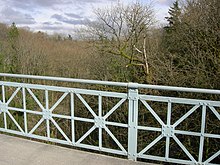railing
A railing is a fall protection or a tour guide element.
use
One finds railings
- Buildings (on balconies , roof gardens, stairs , with windows with low parapets (less than 80 cm) or in front of floor-to-ceiling glass facades).
- Paths (loading ramps, bridges , embankments, ...)
- Vehicles (on ships (see railing ), on trucks (silo semitrailers), ...)
- Industrial systems and machines (on cranes, jetties, pipe bridges, containers, silos, ...)
- Special structures (for example on horticultural works of art, observation towers, ...)
- Scaffolding
- other falling edges (on paved banks of water, steamboat docks, ...)
- on technical equipment (on cookers, glass elevator cars, lifting platforms, ...)
Materials are wood, steel, plastic, concrete and others. There are permanently attached railings and those that are easy to dismantle.
conditions
Railings can be used by architects and designers as a specially designed element. The shape and design of the railings then have a defining influence on the overall impression that a building or a facility (also a park, a ship, a machine, etc.) offers.
The shape of the handrails of stairs in buildings is regulated in Germany in the DIN standard 18065 "Building stairs ", in the state building regulations and in the accident prevention regulations (UVV). Banisters must be provided for all stairs with more than three steps.
The horizontal termination is usually referred to as a handrail . The handrail is firmly mounted on the vertical railing post, with all-glass railing on the statically acting safety glass . Between the railing posts and the handrail there are fillings (plates, glass, perforated sheet metal, wire, ropes or other patterns and materials) or bars vertically (with a maximum of 12 cm bar spacing, 8.9 cm applies to kindergartens and day-care centers) or one to two horizontal knee bars (with a maximum distance of 50 cm) and a baseboard.
The railing structures are usually given thermal expansion compensations, which also represent the assembly joints.
height
Handrails must be at least 90 cm high - measured over the front edge of the step (at least 100 cm in workplaces). For fall heights of more than 12 m, a height of at least 110 cm is usually required for all buildings. The individual federal states have different regulations for this. In Baden-Württemberg, a height of 90 cm is required even above a 12 m fall height. If the width of the fence (e.g. for escalators) offers additional protection against falling, the above mentioned. The minimum heights are not exceeded accordingly.
Bridge railings serve as fall protection for pedestrians or cyclists. The railings are made of steel or aluminum and have a minimum height of 1.0 m for a fall height of less than 12 m, for a greater fall height the minimum height is 1.1 m. In addition to bike paths, a railing height of at least 1.3 m is required in Germany. Some bridge railings have a steel cable in the handrail to secure vehicles in the event of an accident. The recommendations for cycling facilities suggest a railing height of 1.30 m.
Security aspects
In the case of older railings, it is advisable not to lean against the railing (in groups), as it is usually difficult to assess how far the material is weakened in the area of the railing post fixation. Wear and tear can result from aging. This includes corrosion in steel, rotting in wood, embrittlement in plastics, due to stress and other influences. By using permanent corrosion protection systems such as hot-dip galvanizing or a duplex system (hot-dip galvanizing plus coating) or by using stainless steel, corrosion on steel railings is almost impossible today.
If problems arise with metal balcony railings in the area of the railing posts, you can get a grip on them by attaching them to the side or (even better) by taking measures on the underside of the balcony.
For bridges (as well as for some other structures), DIN 1076 prescribes annual stability tests. This always includes checking the railings.
Statics
The railing height relevant for the design by the structural engineer ( structural engineer ) corresponds to the cantilever arm length of the railing and is often not identical to the parapet height . While the parapet height is measured from the finished floor, the cantilever length is measured from the fastening point of the railing. If the railing z. B. attached to the end of a balcony, which also has a high floor structure, the cantilever length can be 20 to 30 cm greater than the actual parapet height.

The structural engineering engineer usually calculates the required material thicknesses and sizes of the fasteners for the railings, even though a number of railings are erected by locksmiths, carpenters, joiners or other craftsmen or designers etc. without a static calculation. If a person is harmed in this way, this may become criminally relevant.
According to DIN EN 1991-1-1 or DIN EN 1991-1-1 / NA, in addition to the dead weight of the railing, horizontal and vertical loads that arise from wind, people or leaning must also be accepted. In the standard, three different rail pressures (horizontal load at the height of the railing rail) are specified for different usage categories. A load of 0.5 kN / m applies to apartments and offices (corresponds to around 50 kg per meter of railing). It is 1.0 kN / m in assembly and sales rooms as well as in factories and workshops, and 2.0 kN / m for buildings with large gatherings of people (concert halls or grandstands). The loads are to be applied at the top or the handrail. A structural engineer determines the relevant loads, from which the post spacing and profile cross-sections result.
Normally, no new static calculations need to be created for railings from the catalog if a type structural analysis has been created and this has been checked by the structural engineer and approved for execution.
Assembly
Since the failure of a component connection on the railing can lead to a risk to life or health of people or significant economic consequences, railings should always be dimensioned and fastened after approval.
For anchoring a balcony slab, only crack-resistant, tension-free or expansion pressure-free, officially approved dowels made of stainless steel V4A may be used in the front edge area . These are usually adhesive anchors suitable for tension zones as well as undercut anchors. Corrosion (caused by stress cracks and on component connections) must always be avoided. To avoid contact corrosion , for example, stainless steel railings must not be attached with galvanized screws.
Classification of the railings
Basics
- Year of construction / epoch and region
- Design (designer / architect, engineers, artists, craftsmen)
- Form (individual or typed (bulk goods))
- Handrail with railing infill, cross bar railing, knee railing, railing with paneling
- Steel pipe railing, steel cable railing, slat railing, glass railing, precast reinforced concrete, masonry railing
- Sheets, glass, perforated sheet metal, wire, ropes
- Manufacture by
- Craft:
- Stonemason (sculptor), bricklayer, blacksmith, carpenter, locksmith, glazier, carpenter (carpenter)
- Industry:
- Glass, metal, wood or plastic plants (or factories)
- Artists and autodidacts, ...
- Craft:
- Material ( glass , rope, fabric, asbestos-cement fiber board, PVC corrugated sheet)
- Statics (calculation for single railings or types / system railings or without calculation based on the person's feeling and / or experience)
- Additional elements on railings (flower box holder, privacy and wind protection, clothesline holder, climbing protection, holder for parasols, satellite antennas, ...)
- Function (fall protection, routing, ornament)
All-glass railing
All-glass railings are characterized by the fact that there are no other (statically effective) structural elements such as railing bars or posts. All-glass railings are usually designed as sheets of safety glass that are braced in the floor . Likewise, railings are often (incorrectly) referred to that have a fall protection made of glass panes, in which only the intermediate elements are made of glass. In order to ensure the safety of the construction, the technical guidelines for fall-proof glazing (TRAV) must be applied. If no building product with regular approval is used, evidence of compliance with the TRAV must be provided and approval in individual cases (ZiE) applied for. With the introduction of DIN 18008, there is now a basis to be able to carry out a static calculation of glasses. A ZiE can thus be avoided in many cases.
Examples
- Emperor bollard railing , Magdeburg
- Light rail railing , Vienna
See also
literature
- Hans-Walter Goldelius: balcony and stair railings. Plan, design and assemble correctly. Coleman Publisher, 2001, ISBN 3-87128-054-2 .
- Willibald Mannes : Stairs and railings. Verlagsgesellschaft Rudolf Müller, 2004, ISBN 3-481-02125-9 .
- DIN ISO 18065: stairs; Terms.
- Publications of the German Institute for Stair Safety
- BGI / GUV-I 561, 'Information stairs' of the German Social Accident Insurance (DGUV) (formerly BG information "stairs" BGI 561)
Web links
- Switzerland: www.suva.ch/gelaender Standards and other recognized rules in Switzerland
Individual evidence
- ↑ Workplace Directive ASR 12 / 1-3
- ↑ Federal Highway Research Institute: Additional technical contractual conditions and guidelines for civil engineering ZTV-ING, Part 8 Structural equipment, Section 4 Restraint systems, Table 8.4.1 Minimum dimensions, as of 2013/12: [1]
- ↑ Section Reports and Standards on the website of the German Institute for Stair Safety , accessed in June 2016
- ^ Information stairs , accessed in June 2016






